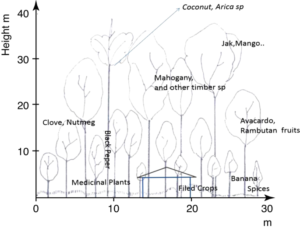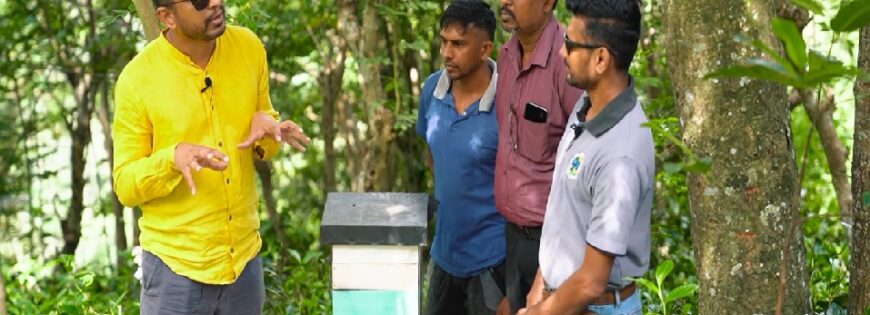Sri Lanka, famous for its tea plantations, coconut groves, and spice gardens also boasts a unique agricultural system called the Kandyan Home Garden, which has been practised for centuries by the indigenous Kandyan communities in the Central Highlands. The Kandyan Home Garden is a sustainable agricultural system that combines food crops, medicinal plants, fruit trees, and timber species in a small-scale, agroforestry-based landscape.
Historic Background of Kandyan Home Gardens
The system was introduced to Sri Lanka during the Kandyan period, which lasted from the late 15th century until the early 19th century. During this period, the Kandyan Kingdom was the most prominent kingdom in Sri Lanka, and the system was developed as a response to the challenges of agricultural production in the region. The system allowed families to grow a diverse range of crops, including those that were resistant to drought and pests, which were common challenges in the region.
The Kandyan Home Gardens were key to Sri Lanka’s agriculture and maintenance of biodiversity. The system was designed to provide a sustainable means of food production, and the gardens were managed in a manner that ensured the preservation of the environment. The system allowed for the efficient use of resources, and the inter cropping of crops helped to reduce the impact of pests and diseases. The gardens were also used to cultivate medicinal plants, which were used to treat a variety of ailments.

(image credit: https://link.springer.com/chapter/10.1007/978-3-030-92365-5_27)
The uniqueness of the Kandyan Home Gardens lies in its design and function. The system is based on the principle of biodiversity, which is essential for the preservation of the environment. The gardens are managed in a way that ensures the efficient use of resources, and the inter-cropping of crops helps to reduce the impact of pests and diseases. The system is also designed to be sustainable, which ensures that it can continue to provide a source of food and other resources for generations to come.
Research has shown that the Kandyan Home Gardens are unique to Sri Lanka and are not found anywhere else in the world. The system has been recognised for its cultural and ecological value, and efforts are underway to promote and preserve this unique agricultural system. The Kandyan Home Gardens represent a sustainable and efficient means of food production and offer valuable insights into how agriculture can be managed in a way that preserves the environment and ensures food security.
Present Status of Kandyan Home Gardens
Despite the increasing pressures of urbanization and industrialization, the Kandyan Home Garden system has survived to this day. According to a study published in the journal Agroforestry Systems, Kandyan Home Gardens cover an area of approximately 280,000 hectares in Sri Lanka, providing a variety of products and services to local communities. In addition to providing food and income, Kandyan Home Gardens also serve as a habitat for a wide range of biodiversity, including birds, insects, and mammals.
Similarities to Regenerative Agriculture
The Kandyan Home Garden system is similar to regenerative agriculture practices being promoted around the world in several ways. Firstly, both systems prioritize soil health and fertility. In the Kandyan Home Garden, soil is enriched with organic matter from decomposing leaves and other plant materials. Similarly, regenerative agriculture practices emphasize the importance of soil health by promoting the use of cover crops, compost, and other natural soil amendments.
Secondly, both systems emphasize the importance of biodiversity. The Kandyan Home Garden system is characterized by the integration of multiple species of trees, shrubs, and herbs, which create a complex ecosystem that supports a variety of flora and fauna. Similarly, regenerative agriculture practices promote the use of diverse crops and cover crops, which provide habitat for beneficial insects and other wildlife.
Thirdly, both systems prioritize the conservation of natural resources. The Kandyan Home Garden system promotes the sustainable use of natural resources such as water and timber, while regenerative agriculture practices prioritize the conservation of soil, water, and biodiversity.
Goodfolks’ support for Kandyan Home Gardens as part of its Regenerative Agriculture drive
Goodfolks, as a brand committed to promoting and sourcing from regenerative agriculture methods, has recognised the importance of traditional agricultural systems such as the Kandyan Home Gardens. By supporting and promoting the use of these systems, Goodfolks is helping to preserve the cultural and ecological value of the gardens and also ensuring the continued availability of diverse and nutritious food sources. Goodfolks’ commitment to promoting regenerative agriculture aligns well with the principles of the Kandyan Home Gardens, which are based on sustainable and efficient use of resources. As the brand continues to grow and become one of the world’s pioneering brands promoting regenerative agriculture, it will undoubtedly continue to play a crucial role in the preservation and promotion of traditional agricultural systems such as the Kandyan Home Gardens.
View video of our visit to a similar garden in 2022
Sources and Studies on Kandyan Home Gardens
“Kandyan Home Gardens: A Traditional Agroforestry System in Sri Lanka.” Agroforestry Systems, vol. 58, no. 1, 2003, pp. 21–34., doi:10.1023/A:1023919107067.
“Traditional Home Gardens of Sri Lanka: A Study of Their Composition, Structure, and Functioning.” Agroforestry Systems, vol. 38, no. 2, 1997, pp. 139–164., doi:10.1023/A:1005857200308.
“Kandyan Home Gardens and Their Contribution to Rural Livelihoods in Sri Lanka.” Agroforestry Systems, vol. 91, no. 2, 2017, pp. 243–259., doi:10.1007/s10457-016
“Kandyan Home Garden”. Food and Agriculture Organization of the United Nations, http://www.fao.org/3/a-bp243e.pdf
Weerasinghe, W.M.U.B. “Kandyan Home Gardens in Sri Lanka: A Case Study of their Agroforestry Components”. Agroforestry Systems, vol. 15, no. 1, 1991, pp. 49-66.
Ranasinghe, R. (2015). Home gardens in Sri Lanka: A unique agroforestry system to maintain biodiversity and ecosystem services. Agroforestry Systems, 89(5), 819-831.



